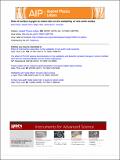Role of surface oxygen-to-metal ratio on the wettability of rare-earth oxides
Author(s)
Khan, Sami; Azimi, Gisele; Yildiz, Bilge; Varanasi, Kripa
DownloadVaranasi_Role of.pdf (1019.Kb)
PUBLISHER_POLICY
Publisher Policy
Article is made available in accordance with the publisher's policy and may be subject to US copyright law. Please refer to the publisher's site for terms of use.
Terms of use
Metadata
Show full item recordAbstract
Hydrophobic surfaces that are robust can have widespread applications in drop-wise condensation, anti-corrosion, and anti-icing. Recently, it was shown that the class of ceramics comprising the lanthanide series rare-earth oxides (REOs) is intrinsically hydrophobic. The unique electronic structure of the rare-earth metal atom inhibits hydrogen bonding with interfacial water molecules resulting in a hydrophobic hydration structure where the surface oxygen atoms are the only hydrogen bonding sites. Hence, the presence of excess surface oxygen can lead to increased hydrogen bonding and thereby reduce hydrophobicity of REOs. Herein, we demonstrate how surface stoichiometry and surface relaxations can impact wetting properties of REOs. Using X-ray Photoelectron Spectroscopy and wetting measurements, we show that freshly sputtered ceria is hydrophilic due to excess surface oxygen (shown to have an O/Ce ratio of ∼3 and a water contact angle of ∼15°), which when relaxed in a clean, ultra-high vacuum environment isolated from airborne contaminants reaches close to stoichiometric O/Ce ratio (∼2.2) and becomes hydrophobic (contact angle of ∼104°). Further, we show that airborne hydrocarbon contaminants do not exclusively impact the wetting properties of REOs, and that relaxed REOs are intrinsically hydrophobic. This study provides insight into the role of surface relaxation on the wettability of REOs.
Date issued
2015-02Department
Massachusetts Institute of Technology. Department of Mechanical Engineering; Massachusetts Institute of Technology. Department of Nuclear Science and Engineering; Massachusetts Institute of Technology. Engineering Systems DivisionJournal
Applied Physics Letters
Publisher
American Institute of Physics (AIP)
Citation
Khan, Sami, Gisele Azimi, Bilge Yildiz, and Kripa K. Varanasi. “Role of Surface Oxygen-to-Metal Ratio on the Wettability of Rare-Earth Oxides.” Appl. Phys. Lett. 106, no. 6 (February 9, 2015): 061601. © 2015 AIP Publishing LLC
Version: Final published version
ISSN
0003-6951
1077-3118